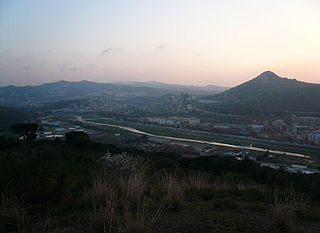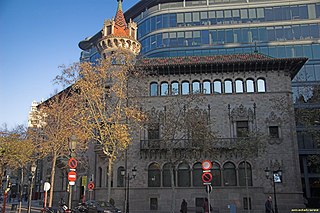
Vallès Occidental is a comarca (county) in Catalonia, Spain. Sabadell and Terrassa are the comarcal capitals. Along with Vallès Oriental it forms the grand comarca of Vallès.

Trambesòs is a tram–light rail system in the Spanish autonomous community of Catalonia that links the Barcelona district of Sant Martí with Badalona and Sant Adrià de Besòs. Its name comes from the union of the words "tram", an abbreviation of the Catalan word for "tram" (tramvia), and "Besòs", the name of an area in the north of the Barcelonès region dominated by the Besòs River.

The Besòs is a river flowing through Catalonia, Spain, formed by the confluence of the Mogent and Congost rivers. It ends in the Mediterranean. Its full watershed includes the following cities: Aiguafreda, La Garriga, Sant Fost de Campsantelles, Canovelles, Granollers, Montmeló, Mollet del Vallès, Montcada i Reixac, Santa Coloma de Gramenet, Barcelona and Sant Adrià de Besòs. Due to its Mediterranean climate, the river can have extreme discrepancies in flow depending on the weather.

Montcada i Reixac, often referred to as simply Montcada, is a municipality in the comarca of the Vallès Occidental in Catalonia, Spain. It is situated at the confluence of the Ripoll river and the Besós river, and very close to the northernmost neighbourhoods of the city of Barcelona and is therefore a part of the metropolitan area of Barcelona. It had 33,656 inhabitants according to the 2010 census.

Line 9 is a completely automated line of the Barcelona Metro network that is currently under construction, with 24 stations open in Barcelona and El Prat de Llobregat, L'Hospitalet de Llobregat, Badalona and Santa Coloma de Gramenet suburbs, since December 2009. The line is currently disconnected in two branches, with a connecting part between the two yet to be built. The Aeroport T1 – Zona Universitària section is called L9 South, and the La Sagrera – Can Zam portion L9 North. Upon completion, it will be the longest underground metro line in Europe.
— Line 8, coloured pink and operated by FGC, is part of the Barcelona Metro network, and therefore of the larger ATM fare-integrated transport system. It joins Plaça Espanya, in the Sants-Montjuïc district of Barcelona with metropolitan area municipalities of L'Hospitalet de Llobregat, Cornellà de Llobregat and Sant Boi de Llobregat.

Barcelona, Catalonia, Spain is divided into 10 districts. These are administrated by a councillor designated by the main city council, and each of them have some powers relating to issues such as urbanism or infrastructure in their area. The current division of the city into different districts was approved in 1984. In 2009 Barcelona started using a new division of 73 neighbourhoods, a division that was done for a better service from the City Council.

The R3 is a line of Rodalies de Catalunya's Barcelona commuter rail service, operated by Renfe Operadora. It runs northwards from the Barcelona area to the French border town of Latour-de-Carol, passing through the Vallès Oriental, Osona and Ripollès regions. With a total line length of 165.9 kilometres (103.1 mi), it extends notably beyond the limits of the Barcelona metropolitan area, reaching the Pyrenees mountains. According to 2008 data, the line's average weekday ridership is 22,841.

Airport T2 is both a Rodalies de Catalunya commuter rail station and a Barcelona Metro station serving terminal complex T2 of Barcelona–El Prat Airport. They are located adjacent to the airport's terminal T2B, in the municipality of El Prat de Llobregat, to the southwest of Barcelona, in Catalonia, Spain. The Rodalies de Catalunya station is the southern terminus of the current rail link coming from El Prat de Llobregat railway station. It is operated by Renfe Operadora and is served by Barcelona commuter rail service line R2 Nord. The metro station is on the airport branch of Barcelona Metro line 9 (L9) and is operated by Transports Metropolitans de Barcelona (TMB).

Rail transport in Catalonia operates on three rail gauges and services are operated by a variety of public operators:

The Llobregat–Anoia Line is an unconnected metre gauge railway line linking Barcelona with the Baix Llobregat, Bages and Anoia regions, in Catalonia, Spain. Its name refers to the fact that it follows the course of the Llobregat and Anoia rivers for most of its length. Plaça d'Espanya station serves as the Barcelona terminus of the line, then continuing northwards to Martorell, where two main branches to Manresa and Igualada are formed. It also includes several freight branches, accounting for a total line length of 138 kilometres (86 mi) and 41 passenger stations.

Public transport in L'Hospitalet de Llobregat is operated by several companies, most of which are part of the Autoritat del Transport Metropolità, a transport authority managing services in the metropolitan area of Barcelona. L'Hospitalet is located immediately to the west of Barcelona's Sants-Montjuïc and Les Corts districts, meaning transit between the two cities is quite straightforward, even though it was not fully implemented until late. This article intends to list the different transportation services within limits of the municipality of L'Hospitalet.
Public transport in Barcelona is operated by several companies, most of which are part of the Autoritat del Transport Metropolità, a transport authority managing services in the Barcelonès and the rest of the metropolitan area of Barcelona. This article is a summary with transport facilities and services strictly within the municipality of Barcelona, and contains links to more specific articles.

Public transport in Badalona consists of a variety of services operated by several companies, most of them associated with Autoritat del Transport Metropolità, the main transport authority of the Metropolitan Area of Barcelona. At just over 220,000 inhabitants, Badalona is one of Catalonia's most populated towns, and is located immediately next to the capital Barcelona, along the Mediterranean Sea coastline. It is both a dormitory town and a developed city in itself, which makes the proper articulation of transport of vital importance.

Public transport in Santa Coloma de Gramenet is an important part of the Metropolitan Area of Barcelona transportation network. Santa Coloma is a densely populated suburb of the city of Barcelona which fulfills both the role of dormitory town and one of the biggest settlements in the capital's urban area, at around 120,000 inhabitants, and is straddled by Barcelona's Nou Barris and Sant Andreu districts, Badalona, Sant Adrià de Besòs and Montcada i Reixac. The town still relies mostly on bus lines for transportation, but essential improvement arrived in late 2009 with the partial construction of Barcelona Metro line L9. In the future, Generalitat de Catalunya will construct a new line of Tram.

Public transport in Cornellà de Llobregat is an important part of the transportation network spanning the Metropolitan Area of Barcelona. The city of Cornellà, a mostly working-class area with strong dormitory town traits, is one of the most populated in the Baix Llobregat with about 90,000 inhabitants and a daily destination for thousands of commuters in the urban area of the capital.

Public transport in Castelldefels belongs to the broader Metropolitan Area of Barcelona transportation network, organised around the entity Autoritat del Transport Metropolità (ATM). Castelldefels is both a dormitory town, with many commuters driving everyday into Barcelona, and an important locality in itself.
TramVallès, Tramvallès or Tramvia del Vallès is a proposed tram or light rail network in the metropolitan area of Barcelona. Its name stems from the region of Vallès, which spans two counties north of the Catalan capital. The region is densely populated, includes the Autonomous University of Barcelona and current public transport services are insufficient for commuters. Following expressions of citizen support, the Generalitat de Catalunya, the governing body of Catalonia, approved the project in 2010. Tramvallès would serve the following municipalities: Montcada i Reixac, Ripollet, Cerdanyola del Vallès, Badia del Vallès, Sant Cugat del Vallès, Barberà del Vallès, Sabadell and Terrassa.

The Barcelona Provincial Council Local Museum Network, also known as Catalonia’s Biggest Museum, is a tool for support and collaboration from and for the museums of the province, which makes available to municipalities a series of services and actions aimed at improving, through the provision of direct services and research into viable formulas for supramunicipal cooperation, the management, conservation and dissemination of heritage and the museum facilities of the towns of Barcelona province. It is managed from the Cultural Heritage Office, which in turn depends on the Department of Knowledge and New Technologies of Barcelona Provincial Council.

Historically, the city of Barcelona, in the Spanish autonomous community of Catalonia, had a large tramway network. The city's first tram line opened in 1872, but almost all of these historic lines had closed by 1971, being replaced by buses and by the expanding Barcelona Metro. The one remaining line, the Tramvia Blau, was retained as tourist attraction, using historic rolling stock. However at the beginning of the 21st century, two new tram systems, the Trambaix and Trambesòs, opened in the suburbs of the city.

















